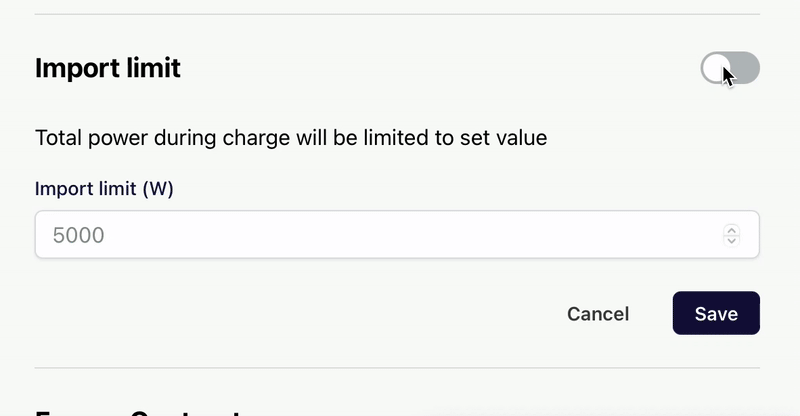Understanding Markedroid’s Import Limit Feature: How It Protects Your Electrical System and Saves You Money
In today’s world, where electric vehicles (EVs) and high-consumption electrical appliances are becoming more common, managing electricity usage efficiently is more important than ever. One way to optimize energy consumption and avoid unnecessary costs or system failures is by setting the MarkeDroid’s new feature Import Limit. But what exactly is an import limit, and why should you care? Let’s dive in.
What Is an Import Limit?

An import limit is a setting in our platform that restricts the maximum amount of electricity that can be drawn from the power grid at any given time. The import limit is particularly useful when charging your home battery.
Why Is an Import Limit Important?
The import limit serves two crucial purposes:
1. Protecting Your Electrical System
Electric systems are designed with specific limits, and exceeding these limits can lead to dangerous consequences. If too much electricity is drawn from the grid, it can cause:
- Fuses to blow, leading to power outages.
- Damage to electrical components.
- Potential fire hazards in extreme cases.
By setting an import limit, you ensure that your electrical system does not exceed safe thresholds, preventing potential failures and hazards.
2. Avoiding High Energy Costs
In countries like Sweden, energy pricing is determined based on the highest three peaks of consumption recorded in a month. Here’s how it works:
-
The energy provider monitors the three highest moments of electricity consumption in a given month.
-
The average of these three peaks is used to determine the per-kilowatt-hour pricing tier you will be charged.
-
Higher consumption peaks result in higher electricity rates, even if they only occurred on a few occasions.
For example, if you charge your EV at night but also try to charge your home battery at the same time, your grid demand can spike significantly. If this happens just a few times in a month, it could push your pricing tier much higher than it would be otherwise, increasing your electricity bill unnecessarily.
How Import Limit Works
When an import limit is set, the system ensures that energy drawn from the grid never exceeds that value. Here’s how it operates in practice:
-
Suppose you set your import limit to 15 kW.
- If your household consumption at a given time is 10 kW, and you attempt to charge your battery, only 5 kW will be allocated for charging.
- Even if your battery could charge at 10 kW, it will be limited to 5 kW to ensure total consumption remains within the 15 kW threshold.
Setting the Right Import Limit
To determine the appropriate import limit, one must consider the capacity of the electrical fuses in place. Electrical fuses have specific ampere (A) ratings, which determine the maximum power they can handle. For safety, the import limit is generally set slightly below the fuse’s maximum capacity. For instance, if a household has a 25A fuse, an import limit of 15 kW would be reasonable to ensure there is a margin for safety and to prevent tripping the fuse.
When Import Limit Applies
It’s important to note that import limits primarily apply in scenarios where a specific buying command is issued when charging a battery. However, in cases where essential household consumption exceeds the set import limit, the system will still allow necessary power intake to prevent outages—prioritizing home needs over optional charging.
Setting an import limit is a smart way to manage energy consumption efficiently. It helps protect your electrical system from damage, prevents unexpected power outages, and reduces high electricity costs caused by occasional spikes in consumption. If you own an electric vehicle or have a high-energy-consuming home setup, implementing an import limit could be a crucial step in optimizing your energy usage while keeping costs in check.


No responses yet